Gram-postive Study guides, Class notes & Summaries
Looking for the best study guides, study notes and summaries about Gram-postive? On this page you'll find 43 study documents about Gram-postive.
Page 3 out of 43 results
Sort by
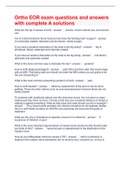
-
Ortho EOR exam questions and answers with complete A solutions
- Exam (elaborations) • 18 pages • 2023
- Available in package deal
-
- $16.49
- + learn more
Ortho EOR exam questions and answers with complete A solutions What are the top 3 causes of AVN trauma, chronic steroid use, and alcohol use For an intertrochanteric femur fracture how does the foot/leg look? surgery? it is externally rotated, abducted and shortened. needs surgery If you have a posterior dislocation of hip what is the leg doing? leg is shortened, flexed, adducted and internally rotated If you have an anterior dislocation of hip what is the leg doing mid...
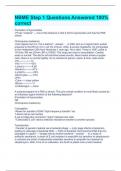
-
NBME Step 1 Questions Answered 100% correct
- Exam (elaborations) • 146 pages • 2023
- Available in package deal
-
- $42.99
- + learn more
NBME Step 1 Questions Answered 100% correct Formation of hypnozoites -Pt has malaria → one of the features is that it forms hypnozoites and has the PBS shown Chloroquine resistance -Can happen but it is not a feature A 30M, who is a migrant farm worker presents to the ED b/c of a 1-wk Hx of fever, chills, & severe headache. He immigrated to the midwestern USA from Honduras 1 year ago. He is alert. Temp is 104F, pulse is 101/min, RR are 20/min, BP is 105/62. The lungs are clear to auscul...
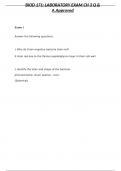
-
1. Why do Gram-negative bacteria stain red? It stain red due to the thinner pepidolglycan layer in their cell wall 2. Identify the stain and shape of the bacteria pictured below. Gram postive : cocci (Spherical)
- Exam (elaborations) • 6 pages • 2023
-
- $17.99
- + learn more
1. Why do Gram-negative bacteria stain red? It stain red due to the thinner pepidolglycan layer in their cell wall 2. Identify the stain and shape of the bacteria pictured below. Gram postive : cocci (Spherical)
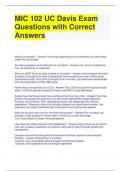
-
MIC 102 UC Davis Exam Questions with Correct Answers
- Exam (elaborations) • 7 pages • 2024
- Available in package deal
-
- $13.69
- + learn more
MIC 102 UC Davis Exam Questions with Correct Answers What is a microbe? - Answer-"free-living organisms so small that they are only visible under the microscope" Are their exceptions to the definition to microbes? - Answer-Yes, some microbes are hug, not free-living, or organisms What is LUCA? And how does it relate to microbes? - Answer-Last Universal Common Ancestor is thought to be what all organisms have evolved from over 4 billion years. Specifically though, the LUCA is thought ...
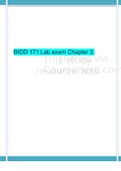
-
BIOD 171 Lab exam Chapter 3 Questions & Answers.
- Exam (elaborations) • 6 pages • 2023
-
- $11.89
- + learn more
BIOD 171 Lab exam Chapter 3. BIOD 171 Lab exam Chapter 3. Lab exam Chapter 3 2. Why is it important to first clean your slide before applying your sample? You must first remove any unwanted contaminants from the slide otherwise it may be difficult to distinguish between the pathogen of interest and a contaminant. 3. When performing a wet mount technique, what is the advantage of using a wax or hydrophobic pen? Creating a hydrophobic barrier (th...
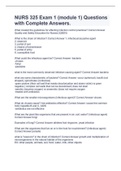
-
NURS 325 Exam 1 (module 1) Questions with Complete Answers.
- Exam (elaborations) • 7 pages • 2023
- Available in package deal
-
- $9.49
- + learn more
What created the guidelines for effecting infection control practices? Correct Answer Quality and Safety Education for Nurses (QSEN) What is the chain of infection? Correct Answer 1. infectious/causative agent 2. reservoir 3. portal of exit 4. means of transmission 5. portal of entry 6. susceptible host What could the infectious agent be? Correct Answer -bacteria -viruses -fungi -parasites what is the most commonly observed infection-causing agent? Correct Answer bacteria wha...
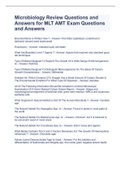
-
Microbiology Review Questions and Answers for MLT AMT Exam Questions and Answers
- Exam (elaborations) • 5 pages • 2023
-
- $10.99
- + learn more
Binomial Name Is Written How ? - Answer- First letter capitalized, underlined or italicized, second word lowercased Endotoxins: - Answer- released upon cell death What Are Biosafety Level 1 Agents ? - Answer- Agents that required only standard good lab techniques Type Of Media Designed To Support The Growth Of A Wide Range Of Microorganisms Is: - Answer- Nutritive Type Of Media Designed To Distinguish Microorganisms On The Basis Of Certain Growth Characteristics: - Answer- Differenti...
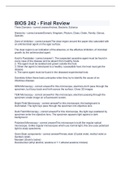
-
BIOS 242 - Final Review 2023 with complete solution questions and answers
- Exam (elaborations) • 7 pages • 2023
-
- $10.99
- + learn more
Three Domains Archea, Bacteria, Eukarya Hierarchy Domain, Kingdom, Phylum, Class, Order, Family, Genus, Species Zone of inhibition The clear region around the paper disc saturated with an antimicrobial agent on the agar surface. The clear region is an indication of the absence, or the effective inhibition, of microbial growth by the antimicrobial agent. Koch's Postulates 1. The suspected causative agent must be found in every case of the disease and be absent from he...
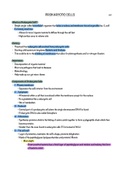
-
Prokaryotic Cells
- Class notes • 2 pages • 2023
-
- $8.09
- + learn more
These notes go through topics such as what is a prokaryotic cell, history, importance, and the individual components of a prokaryotic cell. Components include the plasma membrane, cytoplasm, nucleoid, ribosomes, the cell wall, the capsule, plasmid, flagella, pili, fimbriae, and inclusions. At the end there is a detailed diagram
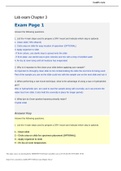
-
Lab exam Chapter 3 BIOD 171learning portage
- Exam (elaborations) • 5 pages • 2022
-
- $9.49
- + learn more
Lab exam Chapter 3 Exam Page 1 Answer the following questions. 1. List the 4 main steps used to prepare a DRY mount and indicate which step is optional. 1. Clean slide( 70% ethanol) 2. Circle area on slide for easy location of specimen (OPTIONAL) 3. Apply organism to slide - If from culture, use sterile loop to spread onto the slide - If from plate; use sterile loop to pick colonies and mix with a drop of sistilled water 4. Air dry at room temp until all moisture has evaporated 2. Why ...

That summary you just bought made someone very happy. Also get paid weekly? Sell your study resources on Stuvia! Discover all about earning on Stuvia


